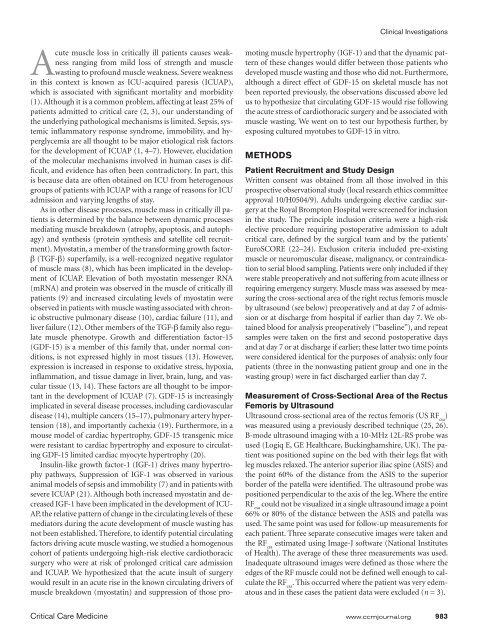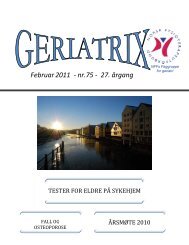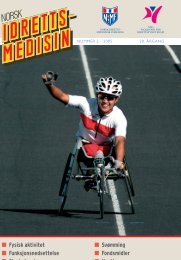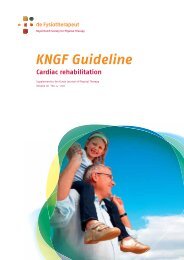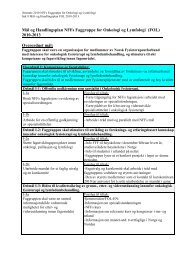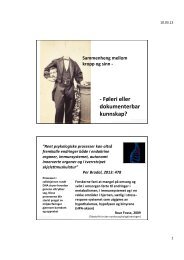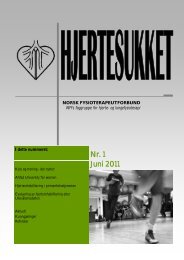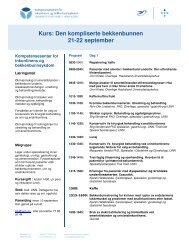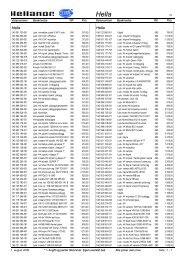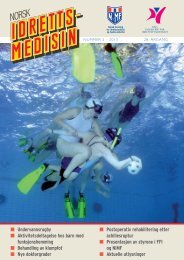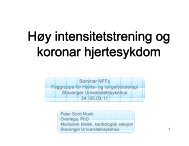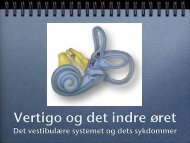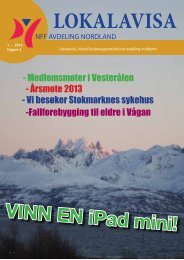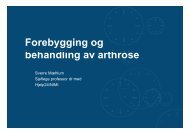Sustained Elevation of Circulating Growth and Differentiation Factor ...
Sustained Elevation of Circulating Growth and Differentiation Factor ...
Sustained Elevation of Circulating Growth and Differentiation Factor ...
Create successful ePaper yourself
Turn your PDF publications into a flip-book with our unique Google optimized e-Paper software.
Clinical InvestigationsAcute muscle loss in critically ill patients causes weaknessranging from mild loss <strong>of</strong> strength <strong>and</strong> musclewasting to pr<strong>of</strong>ound muscle weakness. Severe weaknessin this context is known as ICU-acquired paresis (ICUAP),which is associated with significant mortality <strong>and</strong> morbidity(1). Although it is a common problem, affecting at least 25% <strong>of</strong>patients admitted to critical care (2, 3), our underst<strong>and</strong>ing <strong>of</strong>the underlying pathological mechanisms is limited. Sepsis, systemicinflammatory response syndrome, immobility, <strong>and</strong> hyperglycemiaare all thought to be major etiological risk factorsfor the development <strong>of</strong> ICUAP (1, 4–7). However, elucidation<strong>of</strong> the molecular mechanisms involved in human cases is difficult,<strong>and</strong> evidence has <strong>of</strong>ten been contradictory. In part, thisis because data are <strong>of</strong>ten obtained on ICU from heterogenousgroups <strong>of</strong> patients with ICUAP with a range <strong>of</strong> reasons for ICUadmission <strong>and</strong> varying lengths <strong>of</strong> stay.As in other disease processes, muscle mass in critically ill patientsis determined by the balance between dynamic processesmediating muscle breakdown (atrophy, apoptosis, <strong>and</strong> autophagy)<strong>and</strong> synthesis (protein synthesis <strong>and</strong> satellite cell recruitment).Myostatin, a member <strong>of</strong> the transforming growth factorβ(TGF-β) superfamily, is a well-recognized negative regulator<strong>of</strong> muscle mass (8), which has been implicated in the development<strong>of</strong> ICUAP. <strong>Elevation</strong> <strong>of</strong> both myostatin messenger RNA(mRNA) <strong>and</strong> protein was observed in the muscle <strong>of</strong> critically illpatients (9) <strong>and</strong> increased circulating levels <strong>of</strong> myostatin wereobserved in patients with muscle wasting associated with chronicobstructive pulmonary disease (10), cardiac failure (11), <strong>and</strong>liver failure (12). Other members <strong>of</strong> the TGF-β family also regulatemuscle phenotype. <strong>Growth</strong> <strong>and</strong> differentiation factor-15(GDF-15) is a member <strong>of</strong> this family that, under normal conditions,is not expressed highly in most tissues (13). However,expression is increased in response to oxidative stress, hypoxia,inflammation, <strong>and</strong> tissue damage in liver, brain, lung, <strong>and</strong> vasculartissue (13, 14). These factors are all thought to be importantin the development <strong>of</strong> ICUAP (7). GDF-15 is increasinglyimplicated in several disease processes, including cardiovasculardisease (14), multiple cancers (15–17), pulmonary artery hypertension(18), <strong>and</strong> importantly cachexia (19). Furthermore, in amouse model <strong>of</strong> cardiac hypertrophy, GDF-15 transgenic micewere resistant to cardiac hypertrophy <strong>and</strong> exposure to circulatingGDF-15 limited cardiac myocyte hypertrophy (20).Insulin-like growth factor-1 (IGF-1) drives many hypertrophypathways. Suppression <strong>of</strong> IGF-1 was observed in variousanimal models <strong>of</strong> sepsis <strong>and</strong> immobility (7) <strong>and</strong> in patients withsevere ICUAP (21). Although both increased myostatin <strong>and</strong> decreasedIGF-1 have been implicated in the development <strong>of</strong> ICU-AP, the relative pattern <strong>of</strong> change in the circulating levels <strong>of</strong> thesemediators during the acute development <strong>of</strong> muscle wasting hasnot been established. Therefore, to identify potential circulatingfactors driving acute muscle wasting, we studied a homogenouscohort <strong>of</strong> patients undergoing high-risk elective cardiothoracicsurgery who were at risk <strong>of</strong> prolonged critical care admission<strong>and</strong> ICUAP. We hypothesized that the acute insult <strong>of</strong> surgerywould result in an acute rise in the known circulating drivers <strong>of</strong>muscle breakdown (myostatin) <strong>and</strong> suppression <strong>of</strong> those promotingmuscle hypertrophy (IGF-1) <strong>and</strong> that the dynamic pattern<strong>of</strong> these changes would differ between those patients whodeveloped muscle wasting <strong>and</strong> those who did not. Furthermore,although a direct effect <strong>of</strong> GDF-15 on skeletal muscle has notbeen reported previously, the observations discussed above ledus to hypothesize that circulating GDF-15 would rise followingthe acute stress <strong>of</strong> cardiothoracic surgery <strong>and</strong> be associated withmuscle wasting. We went on to test our hypothesis further, byexposing cultured myotubes to GDF-15 in vitro.METHODSPatient Recruitment <strong>and</strong> Study DesignWritten consent was obtained from all those involved in thisprospective observational study (local research ethics committeeapproval 10/H0504/9). Adults undergoing elective cardiac surgeryat the Royal Brompton Hospital were screened for inclusionin the study. The principle inclusion criteria were a high-riskelective procedure requiring postoperative admission to adultcritical care, defined by the surgical team <strong>and</strong> by the patients’EuroSCORE (22–24). Exclusion criteria included pre-existingmuscle or neuromuscular disease, malignancy, or contraindicationto serial blood sampling. Patients were only included if theywere stable preoperatively <strong>and</strong> not suffering from acute illness orrequiring emergency surgery. Muscle mass was assessed by measuringthe cross-sectional area <strong>of</strong> the right rectus femoris muscleby ultrasound (see below) preoperatively <strong>and</strong> at day 7 <strong>of</strong> admissionor at discharge from hospital if earlier than day 7. We obtainedblood for analysis preoperatively (“baseline”), <strong>and</strong> repeatsamples were taken on the first <strong>and</strong> second postoperative days<strong>and</strong> at day 7 or at discharge if earlier; these latter two time pointswere considered identical for the purposes <strong>of</strong> analysis: only fourpatients (three in the nonwasting patient group <strong>and</strong> one in thewasting group) were in fact discharged earlier than day 7.Measurement <strong>of</strong> Cross-Sectional Area <strong>of</strong> the RectusFemoris by UltrasoundUltrasound cross-sectional area <strong>of</strong> the rectus femoris (US RF csa)was measured using a previously described technique (25, 26).B-mode ultrasound imaging with a 10-MHz 12L-RS probe wasused (Logiq E, GE Healthcare, Buckinghamshire, UK). The patientwas positioned supine on the bed with their legs flat withleg muscles relaxed. The anterior superior iliac spine (ASIS) <strong>and</strong>the point 60% <strong>of</strong> the distance from the ASIS to the superiorborder <strong>of</strong> the patella were identified. The ultrasound probe waspositioned perpendicular to the axis <strong>of</strong> the leg. Where the entireRF csacould not be visualized in a single ultrasound image a point66% or 80% <strong>of</strong> the distance between the ASIS <strong>and</strong> patella wasused. The same point was used for follow-up measurements foreach patient. Three separate consecutive images were taken <strong>and</strong>the RF csaestimated using Image-J s<strong>of</strong>tware (National Institutes<strong>of</strong> Health). The average <strong>of</strong> these three measurements was used.Inadequate ultrasound images were defined as those where theedges <strong>of</strong> the RF muscle could not be defined well enough to calculatethe RF csa. This occurred where the patient was very edematous<strong>and</strong> in these cases the patient data were excluded (n = 3).Critical Care Medicine www.ccmjournal.org 983


